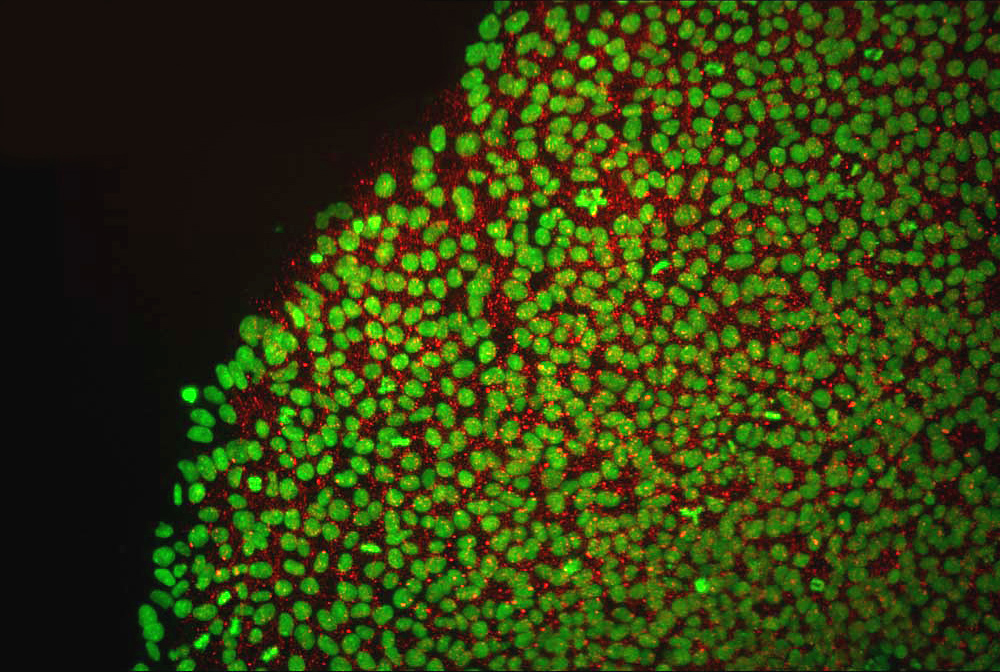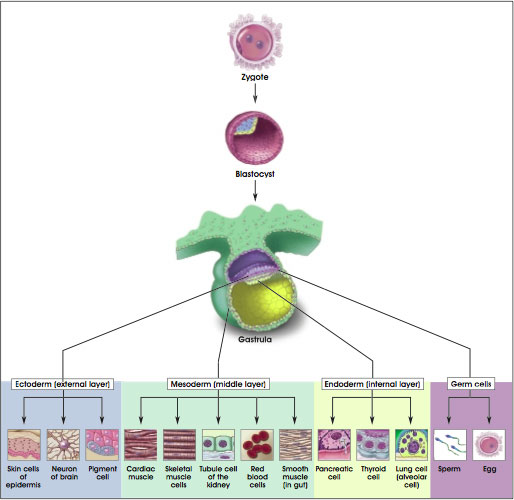But the debate over stem cells is no longer between adamant pro-lifers and research scientists anymore, it has grown into multiple debates over the efficacy, ethical implications, and overall viability of the different types of stem cells available.
Currently there are countless research teams, labs and centers across the nation striving to enable stem cell into practical medical therapies that will treat disease. However, which stem cell types they are using is anyone's guess. Currently there are multiple types of stem cells, each with their own proponents and advocates and members from other camps, casting doubt on the likelihood of the research being brought to fruition.
1) Embryonic Stem Cells:

"This image depicts a colony of human embryonic stem cells grown over a period of 10 months in the absence of mouse feeder cells. The cell nuclei are stained green; the cell surface appears in red." Photo courtesy Ren-He Xu 2004, University of Wisconsin
Working with embryonic stem cells, Geron Corporation has launched human clinical trials to see if evaluate effective and safe repair of spinal damage using stem cells.
2) Adult stem cells:

stem cells are capable of self-renewal for the lifetime of the organism. Unlike embryonic stem cells, at this point in time, there are no isolated adult stem cells that are capable of forming all cells of the body. That is, there is no evidence, at this time, of an adult stem cell that is pluripotent." Caption and Photo credit: National Institutes of Health, Stem Cell Information
Adult stem cells are another option, and advocated heavily by members of the scientific community and public combined. The adult body, although most cells are differentiated, we still have certain types of stem cells that are capable of replacing other cells. We have stem cells with limited differentiation in our adult bodies. Stem cells have been identified in the bone marrow, cornea and retina, liver, skin, pancreas as well as the adult kidneys and gastrointestinal tract. Using adult stem cells avoids the ethical issues surrounding the embryonic stem cells and also the immune rejection due to use of the body's own DNA, but the amount of therapy is limited because the differentiated cells are capable of only certain developments. Recently, a team headed by Dr. Robert Burt, from Northwestern University made a breakthrough in MS treatment, showing reversal of the disease using adult stem cell therapies. New research has also developed methods to re-program adult stem cells to resemble their embryonic counterparts. However, other applications of this research have yet to be established.
3) Parthenote Stem Cells
Parthenote stem cells are stem cells that use only an egg cell, and chemical inducement which causes the egg to divide and become diploid using only its one set of DNA. This technology somewhat avoids the issue faced in embryonic stem cell research considering that parthenote cells cannot fully develop into a complete human being, but all three germ lines are able to be created using parthenote stem cells. Parthenote stem cells have a simpler set of DNA, which allows a greater chance of implantation without immune rejection, but this is only limited, and not negated. Immune rejection is still possible and likely in cases using parthenote stem cells. Currently, creating cornea cells, islet cells and liver cells are areas of research being conducted using parthenote stem cell technology.
International Stem Cell Corporation is currently researching several areas of parthenote stem cell technology in hopes of near future medical therapies.
Although all three camps have initial promising results and practical applications, the debate still rages on about the best possible method to treat disease with the least amount of consequences. Needless to say, we will all be watching with interest so see which, if not all therapies will be unitized in the future.






Comments